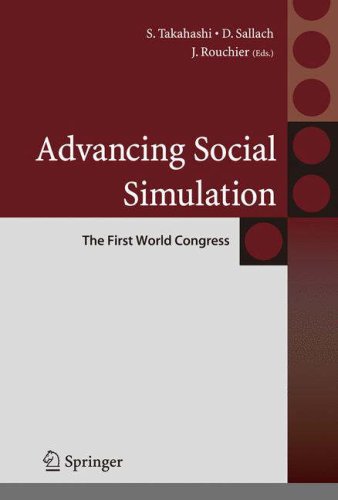Reviewed by
Peter Davis
Director of Social Statistics Research Group, University of Auckland, New Zealand
 This book incorporates 31 papers drawn from the 90 or so presented at the 2006 First World Congress on Social Simulation held in Kyoto. This was the first joint gathering of the European, North American and Asia Pacific associations. A signal event, and a speedy, if "lightly" edited, compilation (a year from conference to publication).
This book incorporates 31 papers drawn from the 90 or so presented at the 2006 First World Congress on Social Simulation held in Kyoto. This was the first joint gathering of the European, North American and Asia Pacific associations. A signal event, and a speedy, if "lightly" edited, compilation (a year from conference to publication). I approach this volume as a recent arrival to the simulation field, and as an observer rather than seasoned practitioner. I also carry a bias looking for the potential of the field both to advance theoretical and conceptual rigour in the social sciences (particularly sociology) and to progress the power of the social sciences to contribute to policy.
The volume is dominated by smart simulation experiments devoted to assessing some feature of interpersonal dynamics, either in a social network, or in an economic setting, or with some other more theoretical feature. These are generally tightly specified, as one would expect with experimental work of this kind, with about half being organised around a conventional game-theoretic model. The interest here is in working through the implications of those tight specifications, usually for some defensible, broader analytical purpose in social psychology, marketing, management or economics. There is also interest in these papers in putting different modelling packages through their paces.
Aside from the simulation experiments of this kind, there are some papers of a more theoretical nature and a few that explore some special computational feature. There is an overall sense here of versatility with formalism and experimental design, but not a lot to excite a social (as opposed to a behavioural) scientist, and certainly little that seemed to advance the parent disciplines or to progress policy application or to be empirically applicable. Nevertheless, this is probably "normal science" in the field of simulation as it develops outside the natural sciences.
For the "social" scientist interested in examples with applicability in a realm of broader ideas and human endeavours, the pickings in this volume are few, but they are there nevertheless. For me there are just eight papers that push the intellectual boundaries beyond the experimental setting to the world of wider theory and social application. These cover the modelling of diverse topics, including the problem of social order, civil wars, language competition, agricultural policy, the history of civilizations, and case studies in historical and environmental anthropology.
As a sociologist looking for the potential that simulation has to address the bigger theoretical and practical issues of the discipline in a rigorous and intellectually appealing way, these papers represent the future of the field. At the risk of playing favourites, let me just mention three. The simulation by Barnaud, Bousquet and Trebuil of rural credit management in a Thailand ("Multi-Agent Simulations to Explore Rules for Rural Credit. Management in a Highland Farming Community of Northern Thailand") demonstrates an interactive approach in which the modellers worked with the local community. Janssen, Sept and Griffith ("Hominidis Foraging in a Complex Landscape: Could Homo ergaster and Australopithecus boisei Meet Their Calories Requirements?") use food availability data from contemporary East African settings to model and explore paleoanthropological questions about hominid survival in a challenging landscape. Finally, Cioffi-Revilla and associates ("Agent-Based Modeling Simulation of Social Adaptation and Long-Term Change in Inner Asia") use agent-based modelling to explore theories of socio-political evolution with territorial data from Central Eurasia over the last 5,000 years. These three demonstrate imagination and intellectual reach, they push the boundaries of modelling, and they hint at the potential for contributions to theory and application. They keep me interested in the field.
Return to Contents
of this issue
© Copyright Journal of Artificial Societies and Social Simulation, 2007